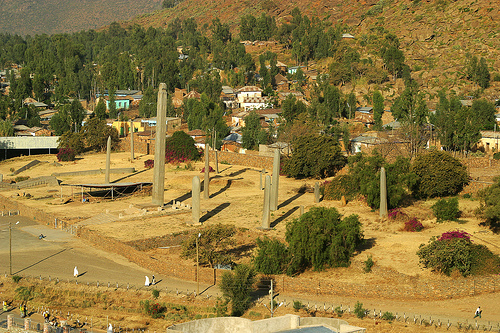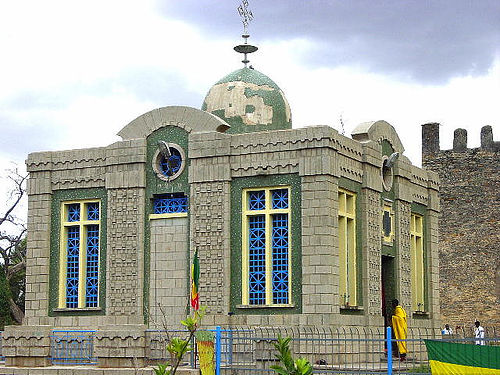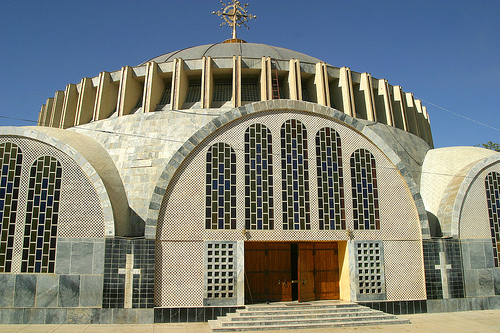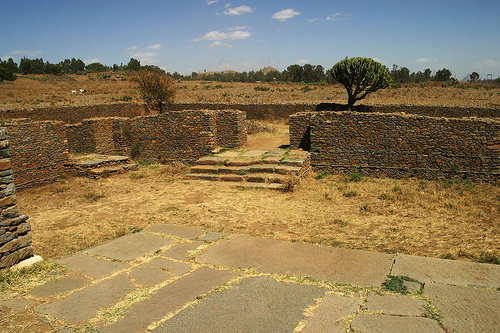

Location: Tigray Province
Axum (also spelled Aksum) is a historic city in northern Ethiopia, located in the Tigray Region, near the base of the Adwa mountains. It is one of the most significant archaeological and cultural sites in Africa, known as the heart of the ancient Aksumite Kingdom (circa 100 CE to 940 CE), a major civilization that played a pivotal role in trade, religion, and culture in the Horn of Africa and beyond.
The Aksumite Kingdom:
Axum was the capital of the Aksumite
Kingdom, which flourished from the 1st to 10th centuries CE. At its
peak, it was one of the most powerful states in the ancient world,
alongside Rome, Persia, and China.
The kingdom controlled trade
routes connecting Africa, the Middle East, and the Mediterranean,
dealing in goods like ivory, gold, incense, and slaves. Its strategic
location near the Red Sea port of Adulis facilitated commerce with the
Roman Empire, India, and Arabia.
Aksum minted its own coinage in
gold, silver, and bronze, a rare feat in sub-Saharan Africa, reflecting
its economic sophistication. These coins, inscribed in Ge’ez, Greek, and
Sabaean, are among the earliest evidence of a monetized African economy.
Adoption of Christianity:
Axum is renowned as one of the first
major empires to adopt Christianity as a state religion in the early 4th
century CE, under King Ezana (circa 330 CE). This makes Ethiopia one of
the oldest Christian nations.
The conversion followed the influence
of Frumentius, a Syrian Christian who became the first bishop of Aksum,
consecrated by the Patriarch of Alexandria. The Ethiopian Orthodox
Tewahedo Church traces its origins to this period.
Aksum’s Christian
heritage is reflected in its churches, stelae, and religious texts, many
of which remain central to Ethiopian identity.
Geopolitical
Influence:
Aksum’s power extended across the Red Sea to parts of
southern Arabia (modern-day Yemen), where it controlled key territories
like Himyar.
The kingdom’s inscriptions, such as the Ezana Stone,
detail military campaigns and the spread of Christianity, written in
Ge’ez, Greek, and Sabaean, showcasing its multilingual and cosmopolitan
nature.
Aksum declined around the 7th–10th centuries due to factors
like the rise of Islamic trade routes, environmental changes, and
internal instability, leading to the capital’s eventual shift southward.

Axum
is a major city in the Northern Ethiopia and a former capital of the
Aksum Kingdom. Ethiopians believe that Chapel of the Tablet in Axum
is a last resting place of the Ark of the Covenant. It is believed
that protection of this religious artifact allowed Ethiopia to stay
independent from colonization by the outsiders. Regardless whether
it is true or not, one thing is for certain: it was the only country
on the continent that remained free from conquest. Chapel of the
Tablet is believed to be the final resting place of the Ark of the
Covenant. After the Babylonians captured Jerusalem the ark
disappered. The Bible left no traces of what actually happened to
this religious artifact. However Ethiopians believe that the ark was
brought to Ethiopia to a small monastery on the lake Tana. Ethiopian
kings believed they were descendents of king Solomon and Queen Sheba
(First Kings 10-13), so it made sense why the Ark with tablets of
Moses were brought to Ethiopia. In the ancient times Ethiopian kings
were crowned here.
Unfortunately no one is allowed to see
the ark itself and even gaze at it. There are no exceptions to this
rule. Only one man is allowed inside the chapel. He takes care of
the ark, but in return he can not leave the premises of the church.
He also has to keep a strict fast for the rest of his life. It seems
that the chapel has no security, but in fact many of the people that
are commonly seen around fence stand guard all the time. If you try
to approach the entrance to the chapel you will immediately realize
that all these resting people get from the ground and approach you.
Particularly impressive is celebration of Timket Festival (Ethiopian
version of Epiphany) that is held on January 7 when many pilgrims
and priests held a service at night surround by torches. Another
important holiday is celebrated on November 24 that is known as
Festival of Maryam (Mary) Zion.
Axum is a UNESCO World Heritage Site (designated in 1980) due to
its extraordinary archaeological remains and cultural
significance. Key sites include:
The Obelisks (Stelae):
Axum is famous for its giant granite stelae, erected as funerary
monuments or markers of royal power between the 1st and 4th
centuries CE.
The Great Stele (33 meters tall, now fallen) is
the largest single block of stone ever attempted to be erected.
The Stele of King Ezana (24 meters) and the Rome Stele (returned
from Italy in 2005) are iconic examples.
These intricately
carved monoliths, some weighing over 500 tons, demonstrate
advanced engineering and artistic skill. They often feature
carvings mimicking multi-story buildings, complete with
“windows” and “doors.”
The stelae are associated with royal
tombs, though many remain unexcavated due to limited resources
and modern settlement atop the sites.
Church of St. Mary
of Zion:

This church complex is one of Ethiopia’s holiest sites, believed
to house the Ark of the Covenant, according to Ethiopian
tradition. The Ark is said to have been brought to Ethiopia by
Menelik I, the son of King Solomon and the Queen of Sheba.
The original church dates to the 4th century, though the current
structure was rebuilt in the 17th century by Emperor Fasilides
and expanded in the 20th century under Emperor Haile Selassie.
Access to the chapel housing the Ark is restricted to a single
guardian monk, adding to its mystique. The church remains a
major pilgrimage site, especially during the Timkat festival.
Palaces and Tombs:
The Palace of Dungur (often called the
“Queen of Sheba’s Palace,” though likely misnamed) is a large,
multi-room structure from the 6th century CE, showcasing
Aksumite architecture with dressed stone and mud mortar.
The
Tomb of the False Door and other subterranean burial chambers
contain intricate stonework and artifacts, though looting and
time have damaged many.
The Ta’akha Maryam and Enda Mikael
complexes are remnants of elite residences or administrative
buildings, indicating a sophisticated urban center.
Inscriptions and Artifacts:
The Ezana Stone, a trilingual
inscription in Ge’ez, Greek, and Sabaean, records King Ezana’s
victories and his conversion to Christianity, akin to the
Rosetta Stone for its historical value.
Museums in Axum house
artifacts like coins, pottery, and glassware, reflecting trade
with Rome, Byzantium, and India. The Axum Archaeological Museum
and the church museum are key repositories.
Queen of Sheba Legend:
Axum is tied to the legend of the
Queen of Sheba, who, according to Ethiopian tradition (recorded
in the Kebra Nagast), visited King Solomon in Jerusalem and bore
his son, Menelik I, the founder of the Solomonic dynasty.
While archaeological evidence for the Queen is scarce, the
narrative underscores Axum’s cultural and religious identity,
linking Ethiopia to biblical history.

This large reservoir was actually designed to hold water rather than serve as a bath for the royalty. In the ancient times it was part of the massive palace complex that covered an area of 3250 square meters. It is known locally as a Dungur or Dungu Addi Kilte. The legend claims that it was erected by the orders of Queen of Sheba. In the Old Testament of the Bible it is claimed that she travelled to Jerusalem to met king Solomon, who became famous for his wisdom. She met him and upon return to Ethiopia she gave birth to their son.
Demographics and Economy:
Modern Axum is a small city with a
population of approximately 66,000 (based on recent estimates). Its
residents are primarily Tigrayan, with Amhara and other ethnic groups
present.
The economy relies on agriculture (teff, wheat, and
livestock), trade, and tourism driven by its historical sites.
Small-scale crafts, like weaving and pottery, also contribute.
The
city has basic infrastructure, including schools, hospitals, and a
university (Aksum University), but faces challenges like poverty and
limited investment.
Cultural Role:
Axum remains a spiritual
center for the Ethiopian Orthodox Tewahedo Church. Major festivals like
Timkat (Epiphany) and Hidar Zion (commemorating St. Mary of Zion) draw
thousands of pilgrims.
The Ge’ez language, still used in liturgy,
originated in Aksum, and the city is a hub for traditional Ethiopian
music, dance, and religious art.
Tourism:
Axum is a key stop
on Ethiopia’s historic circuit, alongside Lalibela and Gondar. Its
UNESCO status and unique heritage attract international visitors, though
numbers fluctuate due to regional instability.
The return of the
looted Rome Stele from Italy in 2005 (taken by Mussolini’s forces in
1937) boosted Axum’s global profile, though reintegration into the stele
park required significant engineering.
Conflict and Instability:
The Tigray War (2020–2022) severely
impacted Axum, with reports of violence, including the alleged massacre
at St. Mary of Zion in November 2020, where hundreds were reportedly
killed. The conflict disrupted tourism, damaged infrastructure, and
strained local communities.
While peace agreements were signed in
2022, ongoing tensions and economic recovery challenges persist,
affecting Axum’s development and preservation efforts.
Archaeological Preservation:
Many of Axum’s sites are threatened by
urban expansion, as modern buildings encroach on unexcavated areas.
Limited funding and expertise hinder comprehensive digs and
conservation.
Weathering, erosion, and past looting (e.g., during
colonial periods) have damaged stelae and structures. Efforts by UNESCO
and the Ethiopian government aim to protect sites, but progress is slow.
Climate and Environment:
Deforestation and soil erosion in the
Tigray Region, exacerbated by climate change, threaten the agricultural
base that supports Axum’s residents.
Water scarcity and drought
cycles further strain the local economy, impacting tourism and heritage
management.
Legacy:
Axum’s influence persists in Ethiopia’s national identity,
particularly through the Solomonic dynasty (1270–1974), which claimed
descent from Aksum’s rulers. The Kebra Nagast remains a cornerstone of
Ethiopian literature.
The Aksumite script (Ge’ez) evolved into the
writing systems used for Amharic, Tigrinya, and other Ethiopian
languages, preserving a linguistic heritage.
Global Recognition:
As a UNESCO site, Axum is celebrated for its universal cultural value,
representing Africa’s contribution to world history. Its Christian
heritage also connects it to global religious narratives.
Scholars
and archaeologists continue to study Axum, with ongoing debates about
its trade networks, urban planning, and the Ark of the Covenant’s
location.
For those interested in visiting:
Getting There: Axum has a small
airport (Axum Airport) with flights from Addis Ababa, Gondar, and
Lalibela. Road travel from Mekelle or Asmara (Eritrea) is possible but
less reliable due to infrastructure and security concerns.
Key
Attractions: The stele fields, St. Mary of Zion, Dungur Palace, and
local museums are must-sees. Guided tours are recommended for historical
context.
Best Time: October to March offers cooler, drier weather.
Timkat (January) is ideal for experiencing cultural vibrancy.
Practical Tips: Visitors should respect religious sites (e.g., dress
modestly, remove shoes in churches). Check travel advisories due to
regional instability, and carry cash (Ethiopian birr), as ATMs and card
payments are limited.